Two or three weeks ago I read Rama Arya’s blog on Qutb Minar and I remarked then that Qutb Minar is probably my favourite place in Delhi and decided I ought to put up a couple of my own pictures, too. It seems to have taken me rather longer to get around to it than I had intended, but here ’tis.
Qutb refers to the whole of the complex, including the tower and several other important buildings. The Qutb Minar itself is a red and orange sandstone tower 72.5m tall. It has a diameter of just over 14m at its base, and just under 3m at the top, and is the tallest tower in India.
A little context: The first of the Moslem invasions of India was by Muhammed, Sultan of Ghur in what is now Afghanistan, in 1192. Is that not wondrous? I’d love to live in a place called Grrr. Having overrun a large part of the Northern Indian plains, he returned to Ghur, leaving his new territory in the hands of his army commander and favourite slave, Qutbuddin Aibak. Qutbuddin decided to leave a monument to his religion that was designed to overawe his new subjects and inspire his own people, and set about building a mosque with a massive tower nearby.
And this is a squinch in Iltutmish’s Tomb. Is not a squinch a wondrous thing also, both in its construct and its name? A squinch is a ‘bridging’ structure, used here to support a dome (now gone). Iltutmish was Shamsuddin Iltutmish (ruled 1211-1236), 3rd ruler of Delhi (after Qutbuddin and Aram).
This is the famous ‘non-rusting’ iron pillar. This stands in the courtyard of the mosque and was here long before the mosque was built. It was made in the reign of Chandragupta II (AD 375-413), is composed of almost pure iron (99.72%) and shows only the slightest sign of rusting. A sanskrit inscription on the pillar indicates that it probably stood originally outside a Vishnu temple, possibly in Bihar, and was moved later to this site. It would probably have had a garuda, the vehicle of Vishna, on the top.
A close-up of the inscription.
Decorative details of the stonework. Most artistic decoration is, as usual with Islamic craftwork, patterned work and verses from the Koran. At Qutb Minar, there are also plentiful stylised, and sometimes surprisingly realistic, depictions of plants with flowers and buds and long, winding stems and tendrils. To construct the mosque, artisans used stone from Hindu and Jain temples and many stones and panels still depict the original carvings, frequently defaced but still recognisable.
Brahminical motifs on the columns of the Quwwat-ul-Islam Mosque. These pillars were originally part of the Hindu and Jain temples destroyed in the area when Qutbuddin built his capital. It is recorded that twenty seven temples were destroyed. They would have been reassembled by Hindu craftsmen, Qutbuddin using local labour.
Another view of the columns on one of the cloisters surrounding the Quwwat-ul-Islam Mosque.
NOTE: My faithful follower might recognise some of these notes and photos, as this is a rehash of part of a post I wrote on Delhi several years ago. I think it’s worth revisiting, since it’s such a wonderful place.
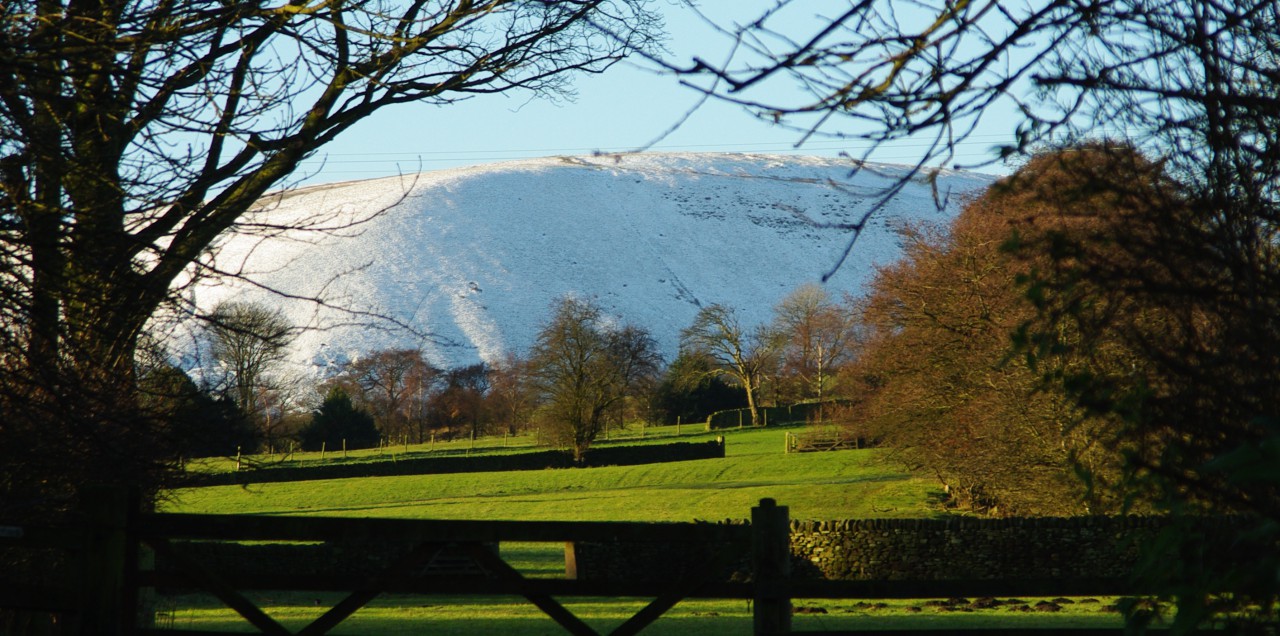


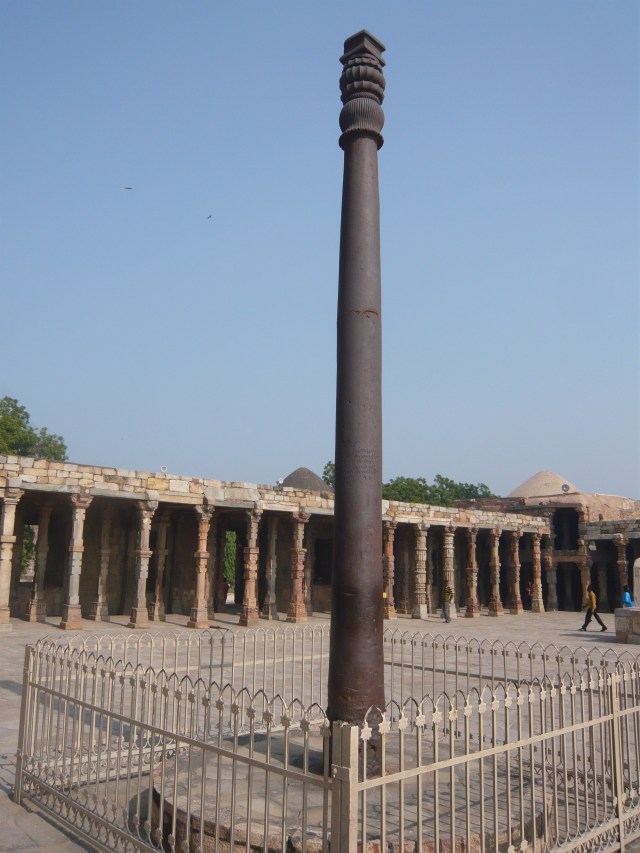
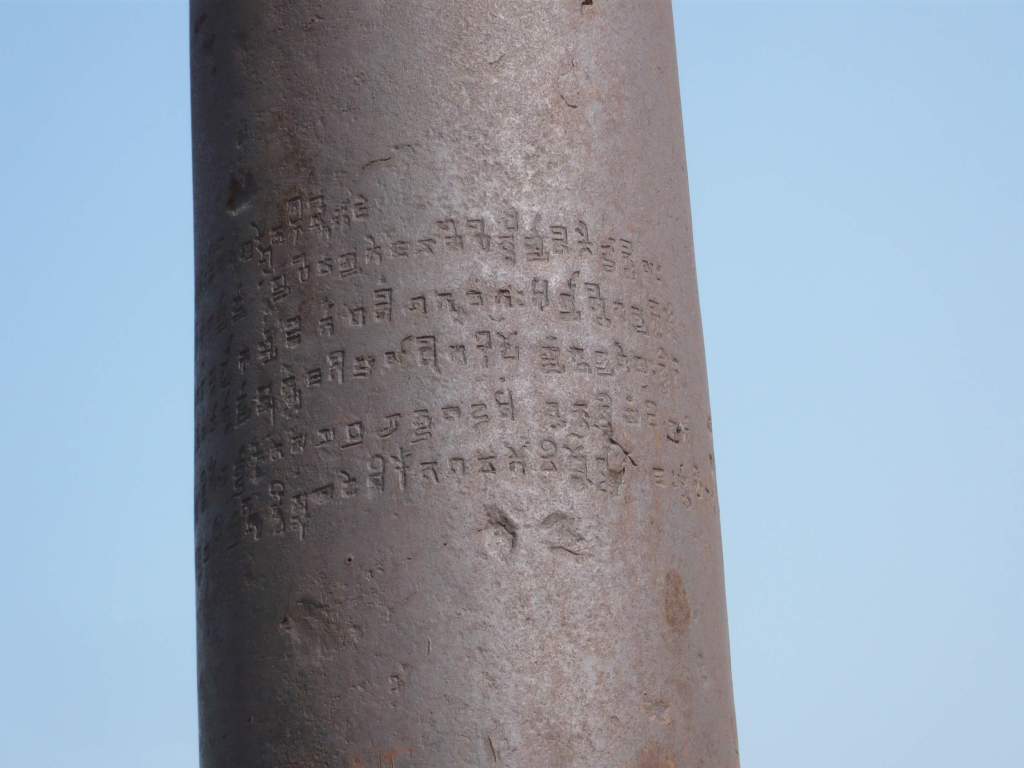
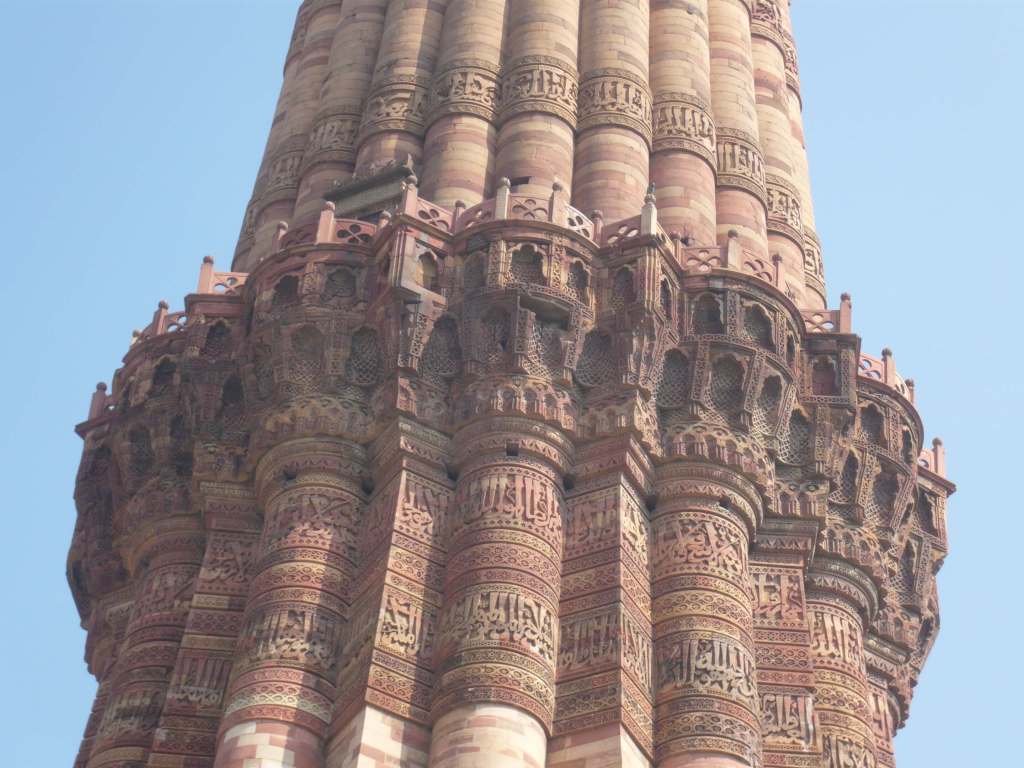
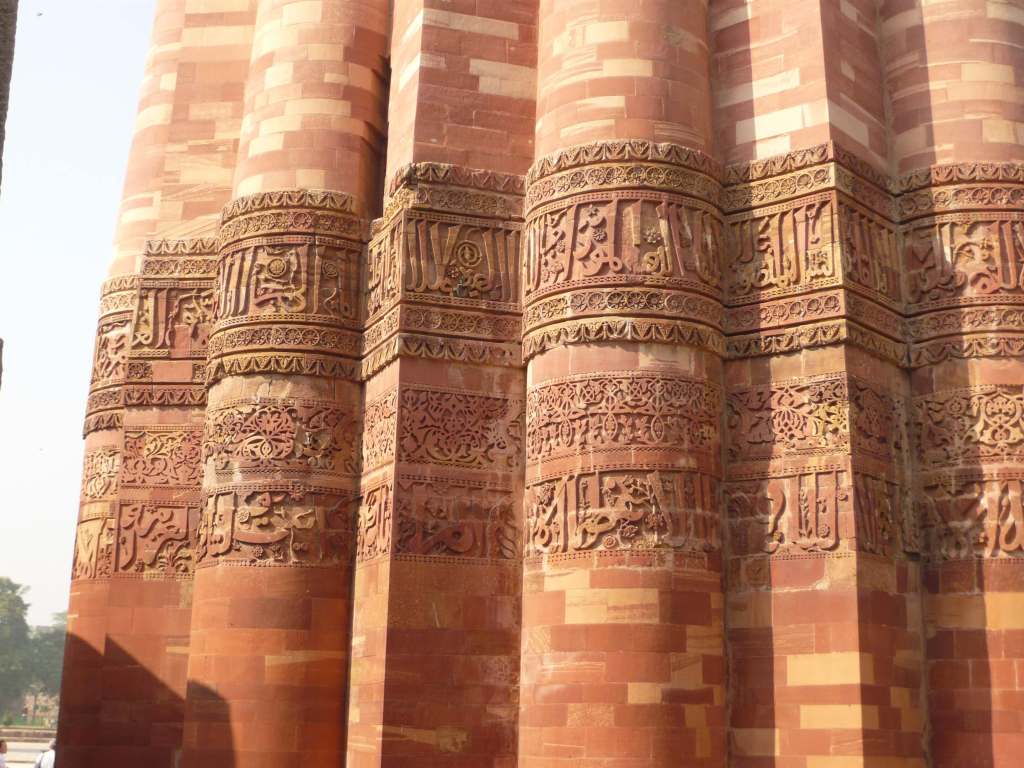
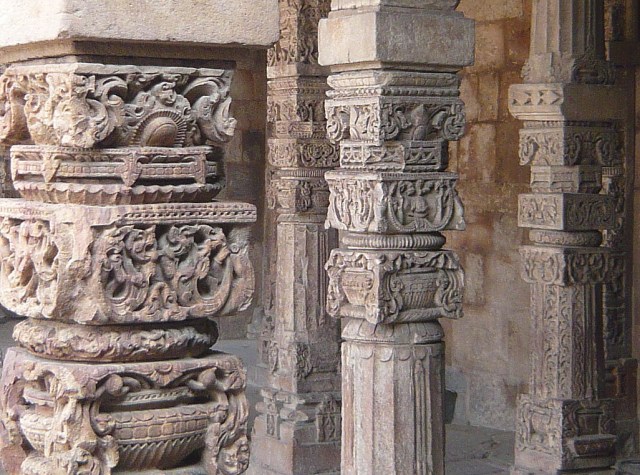
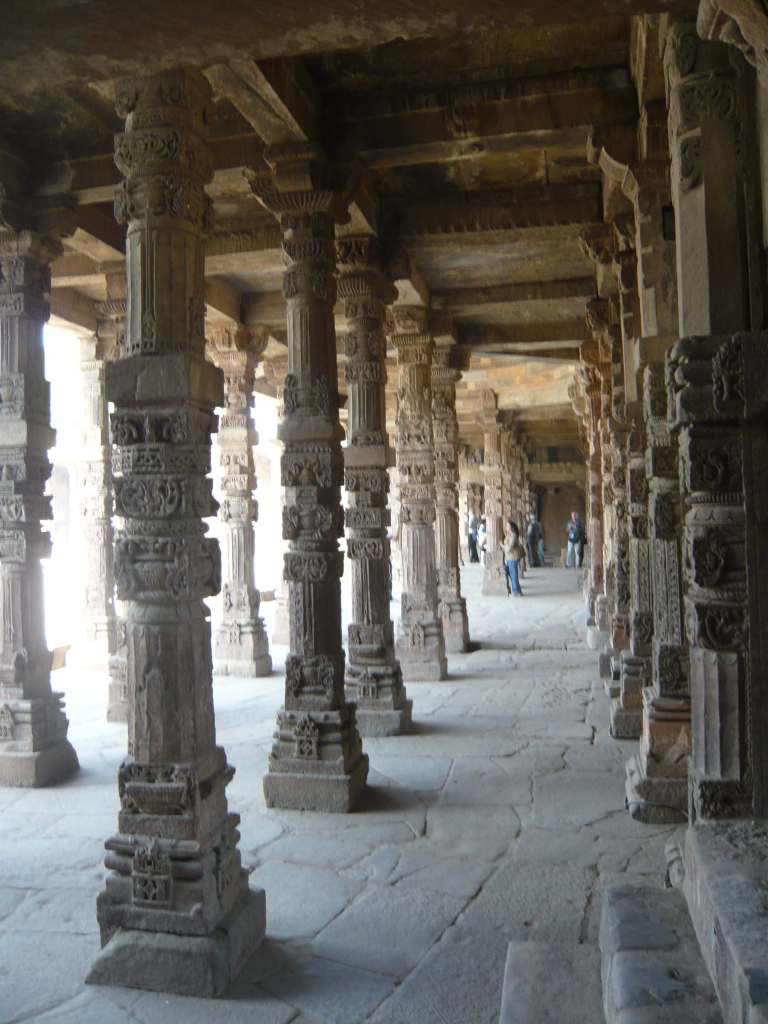
I can tell you had some fun with those names! Grrr sounds groovy!
LikeLiked by 1 person
It sounds great. Or even grrrreat! Definitely a placename to use often.
LikeLike
It’s been a long time since I visited the Minar although Delhi has been on my travel map in recent times. Thanks for the pictorial re visit and the write up, made me want to see it all again.
LikeLiked by 2 people
Certainly worth the effort. If I get back to Delhi I’ll certainly visit it again.
LikeLiked by 2 people
I like the name “Grrrr” 🙂
LikeLiked by 1 person
Me, too. A great name to drop into conversations.
LikeLike
👍😄
LikeLiked by 1 person
Truly beautiful!
LikeLiked by 1 person
It’s a wonderful place, Jill.
LikeLiked by 1 person
The tower looks like a cross between a lighthouse and an elaborate wedding cake. Once I went to some videos that taught me how to pronounce ‘qutb’ and other words, thinks went better; it’s like coming across a plant’s scientific name and not having the slightest idea where to start.
This really was interesting. It’s not a bad thing to be reminded how little I know of certain places in the world when that reminder comes with the chance to learn about them.
LikeLiked by 2 people
It really is a stunning place, no matter how you pronounce it.
LikeLiked by 1 person
Gorgeous photos, Mick. And they built all that without a backhoe!
LikeLiked by 1 person
It’s remarkable what can be achieved with slave labour!
LikeLiked by 1 person
Oy!😩
Sent from my iPhone
<
div dir=”ltr”>
<
blockquote type=”cite”>
LikeLiked by 1 person
Brilliant photos, Mick and a really interesting commentary to go with them. Those buildings and towers are stunning. I love the orange and red sandstone of the Qutb Minar. Your travel posts take me on journeys that I will never have the opportunity to go on myself. I learn so much from the information and images that you share. Thanks for the trip.
LikeLiked by 1 person
You’re welcome, Ellie. Yes, the sandstone is a beautiful colour and texture. The architecture of places like this really takes my breath away.
LikeLiked by 1 person
Fascinating read and photos. I would love to at least visit a place called grrrrr.
LikeLiked by 1 person
It just calls out to you, doesn’t it?
LikeLiked by 1 person
I really enjoyed your photos of the Qutb Minar in Delhi, Mick–the structures, including close-up details, your narrative, and the fun words you pointed out too.
LikeLiked by 1 person
I think you have to love a squinch – a great architectural structure and an even better name! And as for Grrr…
LikeLiked by 1 person
Terrific details in photos and text alike, Mick! Nice humour, also – textual, that is, as photos are usually too literal to be funny …
LikeLiked by 1 person
Thanks, Dave. Aw, I thought I took lots of funny photos.
LikeLike
You did, Mick, made me smile though I tried not to laugh! 🙂
LikeLiked by 1 person
Actually, just reread your post and you play it quite straight. Soz, musta got confused …
LikeLiked by 1 person
Perhaps you read another of my posts – the previous one wasn’t quite so straight!
LikeLiked by 1 person
Ah yes, The Book of Meh, an enjoyable satire – that must be it. Cheers!
LikeLiked by 1 person
Hi Mick, I didn’t know any of this. A fascinating post.
LikeLiked by 1 person
Thanks, Robbie. It’s a fascinating place.
LikeLiked by 1 person
We visited there in Delhi.So much to see and do. Thanks for sharing these images .
Thanks Anita
LikeLiked by 1 person
There is indeed so much. Did you know there are over 10,000 recorded ancient monuments of various kinds in Delhi?
LikeLiked by 1 person
Didn’t see these recorded ancient monuments. Anita
LikeLiked by 1 person
This historical place although is in my city still It has become a childhood memory to visit there. Thank You for reminding me I need to add it in my list to must visit places Mick.
LikeLiked by 1 person
Definitely worth a visit, Meenakshi, as I’m sure you know!
LikeLike
That’s quite an impressive tower. And a non-rusting iron pole is pretty impressive too.
All this time I thought squinch was something you did with your eyes; i.e. squinching them up because the light was too bright. Apparently, slightly different than squinting. In any case, your new definition has enlightened me, so perhaps I’m now squinching my third eye…
LikeLiked by 1 person
We all need a good squinch from time to time, Dave. In fact, any squinch is a good squinch.
LikeLiked by 1 person
Qutb, Ghur, and squinch! What a tongue-twisting trio. I love it. I can see why this place appealed to you. The iron tower is amazing – SO old and looking like it could have been made yesterday. And the carvings are wonderful.
LikeLiked by 1 person
All of that, yes. The iron pillar is especially intriguing, I think, as the people who made it must have had amazing metalwork skills to achieve that level of purity.
LikeLiked by 1 person
I can understand why India was called the Jewel in the Crown.
LikeLiked by 1 person
Me too. There is so much magnificent architecture in India.
LikeLiked by 1 person
All I can see in my mind’s eye when the word India is mentioned is poverty and the Taj Mahal.
LikeLiked by 1 person
There’s certainly a lot of poverty in India, still, but also countless thousands of amazing places, remarkable scenery, and brilliant people. And although there’s a way to go, the poverty is being tackled.
LikeLiked by 1 person
Wonderful pictures and so much history and art that many of us know little about; but of course the world has had so many kingdoms and cultures we can’t take it all in. I love the shot of the tower through the arch, but I guess many photographers have taken the same view!
LikeLiked by 1 person
I suspect everyone who has been there has taken that shot! A phenomenal amount of both history and art in India. The perfect place to go if you like either.
LikeLiked by 1 person
Pingback: Cordoba – Mick Canning